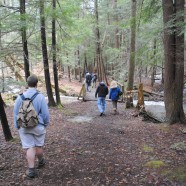HWA Here to Stay?
It’s official friends, HWA has been found in Chautauqua County. Over the holidays, Hemlock Woolly Adelgid (HWA) was encountered on a number of Eastern Hemlock trees (Tsuga canadensis) near Fredonia. These trees exhibited the signs and symptoms of the invasive insect’s presence, having twigs covered in white woolly masses and dying needles, discolored due to loss of nutrients. Due to its small size and discrete nature, HWA can easily go undetected until it is too late, and death of the attacked hemlock is inevitable. However, it CAN be stopped and we CAN help the hemlocks...
Read MoreNo Hemlock Woolly Adelgid Here
This past week RTPI staff, JCC faculty and a number of JCC students conducted surveys in two locations looking specifically for Hemlock Woolly Adelgid or HWA. We are happy to report negative findings for both our survey locations in near Randolph, NY and Warren, PA. In both locations we surveyed, the Hemlocks appeared healthy and free of pests or disease. Our survey efforts are contributing to a large project being led by the US Forest Service and the Nature Conservancy, who have prioritized survey locations within the High Allegheny Plateau ecoregion. Surveys are to be conducted 1-2 times...
Read MoreHemlock Woolly Adelgid
Hi there! For those of you that don’t know me, I am an Eastern Hemlock tree (Tsuga canadensis). I am a native tree that grows in the eastern part of the United States and Canada, and because of my size I am sometimes referred to as the “Redwood of the East.” I can reach upwards of 30 meters or roughly 100 feet in height and can live to be 800 or more years old. I have short, flat needles and long branches that reach up to the canopy and sweep down to the forest floor, creating unique micro-habitats for other species to utilize. Not to sound boastful, but I am a very...
Read More






